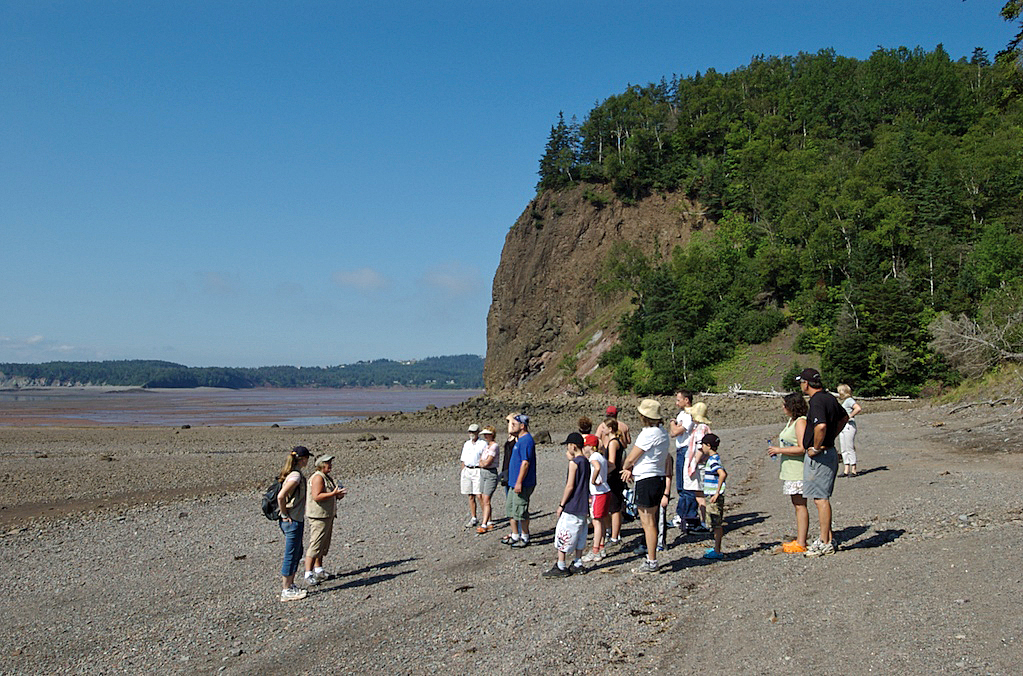Locations Nova Scotia (Part 3): Wasson’s Bluff – a locality near Parrsboro
George Burden (Canada)
The Wasson’s Bluff fossil site, near Parrsboro, is the most geologically recent, yet perhaps the most fascinating of the locations of interest to palaeontologists in Nova Scotia. Located on the Bay of Fundy’s Minas Basin, fossil buffs can view what are perhaps the smallest dinosaur footprints ever found. In 1984, amateur palaeontologist, Eldon George, discovered the track ways, most likely made by a juvenile Coelophysis sp., which lived 200 million years ago, at the Triassic-Jurassic boundary.
Two years later, Neil Shubin of Harvard University and Dr Paul Olsen of Columbia University, discovered at this site over 100,000 tiny bones of ancient crocodiles, various sized dinosaurs, lizards, fishes and sharks. Their efforts were funded by the National Geographic Society, which recognised that this was North America’s largest find ever of fossils from this era.

Vast mudflats in this region’s ancient terrain record the tracks of the creatures from this time. Covered by sand washed down from the Cobequid Highlands, an elevated, quartz bearing area, to the north of Parrsboro, natural casts of the footprints were formed. However, today, this site provides an ideal location to view more than just trace fossils from the crucial Triassic-Jurassic transition period, during which a mass extinction occurred. It is notable in that both the remains of bones and foot prints (which are so clear you can see traces of skin) are found at the same place.

The presence of both bones and trace fossils, straddling both sides of the great Triassic-Jurassic “die-off”, provides unique opportunities to study one of history’s mass extinctions and is unique to Nova Scotia’s Bay of Fundy area. Almost half of the Triassic life forms failed to survive this transition, which may have been triggered by an asteroid impact (although no impact site has been found) or some other catastrophe, such as massive volcanism, world-wide sea level changes or climate change.
The Fundy Geological Museum, in Parrsboro, has exhibits that explain the important findings of this significant transition period from the Triassic to the Jurassic. It is unique for its full-sized prosauropod skeleton of Plateosaurus engeiharitis and for the opportunity to watch technicians in the research lab uncovering and cleaning prosauropod bones that are abundant in this area.
The prosauropods were herbivorous dinosaurs that lived from 230 to 190 million years ago. However, their teeth were not adapted for chewing and they relied on swallowed stones called ‘gastroliths’ to grind their food. They probably died out when vegetation became less abundant at the Triassic-Jurassic boundary. It is worth noting that the ornithischians, which were dinosaurs that could use a movement similar to mammalian side-to-side chewing to crush and process food more effectively, were therefore able to go on to dominate the early Jurassic period.
To see the tiny Coelophysis sp. tracks, visitors will have to leave the confines of the Fundy Geological Museum and venture a little further afield to the Parrsboro Rock and Mineral Shop and Museum, operated by Eldon George. The unique track way is on display here, along with many other fossils George has discovered over the years in the Parrsboro region.

For further information on the unique paleontological and geological history of this area, and for information to help you plan a visit to Nova Scotia, you can go to the following websites:
- Joggins Fossil Cliffs: UNESCO World Heritage Site
- Fundy Geological Museum
- Parrsboro Rock and Mineral Museum
- Nova Scotia Tourism
Overall, Blue Beach, though less heralded, is a hidden treasure awaiting visitors to Nova Scotia, who share an interest in palaeontology.
| Other articles in this series: |
|---|
| Locations in Nova Scotia (Part 1): Joggins – a Carboniferous fossil forest |
| Locations in Nova Scotia (Part 2): Blue Beach – a locality in the Annapolis Valley |
| Locations in Nova Scotia (Part 3): Wasson’s Bluff – a locality near Parrsboro |

